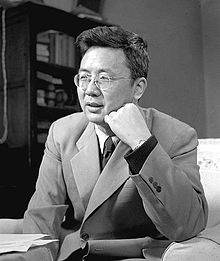Hua Luogeng
Hua Luogeng ( Chinese 華羅庚 / 华罗庚 , Pinyin Huà Luógēng , W.-G. Hua 4 Lo 2 -Keng 1 , also Loo-Keng Hua ; born November 12, 1910 in Jintang , Jiangsu Province, German Empire , † June 12, 1985 in Tokyo ) was a Chinese mathematician who studied number theory , algebra , analysis, and numerical mathematics busy and was the leading mathematician in China in the 20th century.
life and work
Hua grew up in simple circumstances. He was later unable to walk due to typhoid fever. He attended schools in Jintan and Shanghai, where he won a national abacus competition. For financial reasons he could not complete the training and moved back to his family, where he helped his father in his shop. His first publication appeared in 1929, which attracted the attention of the mathematics professor Xiong Qinglai ( Hiong King-lai ) in Beijing, who hired him in the mathematics department of Tsinghua University . He rose quickly (despite a lack of formal qualifications) and became a lecturer. Hua made such an impression on Norbert Wiener , who was passing through , that he recommended him to Godfrey Harold Hardy , who invited him to Cambridge in 1936 .
At the time, Hua was already doing research in additive number theory (Waring's problem about the representability of whole numbers by sums of -th powers) and made the acquaintance of number theorists Harold Davenport and Hans Heilbronn at Cambridge University . During this time he became known for his publications. In 1938 he returned to China, where he became a professor at Tsinghua University, which had now been relocated to Kunming and which had merged with Peking University and Nankai University to form the United Southwest University . Despite adverse circumstances, he managed during this time to improve Vinogradov's estimation of trigonometric sums in number theory. His results were published as a book in Russia in 1947, where he was at the invitation of Vinogradov in 1946. 1959 followed his treatment of trigonometric sums in the newly started encyclopedia of mathematical sciences. In the late 1940s he was also at American universities such as the Institute for Advanced Study . In the meantime, Hua was occupied with algebra (theory of matrices and classical groups, oblique fields, finite fields). In 1963 his book was published with Xian Classical Groups .
In 1948 he was a professor at the University of Illinois , where Raymond Ayoub received his doctorate. He worked with Irving Reiner on the automorphisms of classical groups. At that time, Hua Luogeng was a functionary of the Association of Chinese Scientific Workers in the USA, which is closely related to the CCP (中国 留美 科学 工作者 协会, Pinyin Zhōngguó Líuměi Kēxué Gōngzuòzhě Xiéhuì ), which had a local chapter in Chicago since 1946. After the founding of the People's Republic of China on October 1, 1949, he and his family returned to China in March 1950 on board the SS President Cleveland, a passenger ship of the American President Lines , and became professor again in Beijing. From 1952 he was also director of the newly established Mathematics Institute of the Chinese Academy of Sciences. In the late 1950s he began to be interested in numerical analysis. He also wrote a book about it, but it wasn't published until 1978. In the 1960s, as part of a Communist Party campaign, he roamed factories and villages teaching the use of mathematical methods, which made him very well known across China. He was placed under house arrest during the Cultural Revolution from the mid-1960s, and some of his manuscripts were confiscated and lost. In 1976 he was rehabilitated and became Vice President of the Chinese Academy of Sciences. On behalf of the Chinese leadership, he traveled extensively abroad to re-establish international contacts. 1983/84 he was at Caltech . He died of a heart attack while giving a lecture in Tokyo.
He had been married since 1927 and had six children.
Honors
Hua has received multiple honorary doctorates ( Nancy , University of Illinois , Hong Kong ). He was a member of the National Academy of Sciences of the USA (1982), the German Academy of Sciences Leopoldina and the Bavarian Academy of Sciences .
Fonts
- Selected papers. Springer-Verlag 1983.
- Introduction to Number Theory. Springer-Verlag 1982 (first 1956).
- Harmonic Analysis of Functions of several complex variables in classical domains. AMS 1963 (first 1958).
- Applications of Number Theory to Numerical Analysis. Springer-Verlag 1981 (first 1978).
- Additive prime theory. Teubner 1959 (English AMS 1965).
- Estimates of exponential sums and their application in number theory. Encyclopedia of Mathem. Sciences, Teubner, 1959.
literature
- Chuanming Zong: Analytic number theory in China. In: The Mathematical Intelligencer . Volume 32, No. 1, 2010, pp. 18-25, doi : 10.1007 / s00283-009-9087-1 .
- Yuan Wang : Hua Loo-Keng. A biography. Springer, Singapore et al. 1999, ISBN 981-402103-2 .
Web links
- Literature by and about Hua Luogeng in the catalog of the German National Library
- John J. O'Connor, Edmund F. Robertson : Hua Luogeng. In: MacTutor History of Mathematics archive .
Individual evidence
- ↑ 程 宏 et al .: 1949 年前 后 留美 学生 组织 及其 期刊. In: 93.gov.cn. November 12, 2015, accessed December 4, 2019 (Chinese).
- ↑ 王希 季: 箭 击 长空 忆 当年. In: cas.cn. Retrieved December 5, 2019 (Chinese).
| personal data | |
|---|---|
| SURNAME | Hua, Luogeng |
| ALTERNATIVE NAMES | Hua, loo-keng; 华罗庚; Huà, Luógēng |
| BRIEF DESCRIPTION | Chinese mathematician |
| DATE OF BIRTH | November 12, 1910 |
| PLACE OF BIRTH | Jintang , Jiangsu Province, China |
| DATE OF DEATH | June 12, 1985 |
| Place of death | Tokyo |

